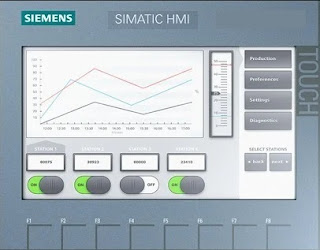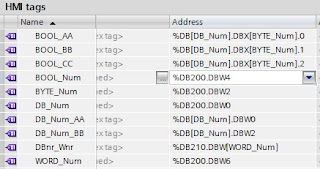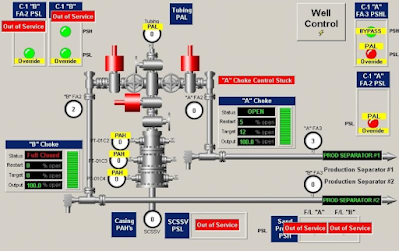HMI | HMI Meaning | What is HMI | HMI Full Form | HMI Display | HMI Panel | Siemens HMI
HMI Full Form is Human-Machine Interface (HMI) is a technology that allows humans to interact with machines in a more natural and intuitive way. This technology is becoming increasingly important as we move towards a world where machines are an integral part of our daily lives.
HMI is used in a wide range of applications, including industrial control systems, automotive systems, medical devices, and consumer electronics. The goal of HMI is to create a user-friendly interface that allows humans to easily control and monitor machines.
One of the key benefits of HMI is that it can improve safety by reducing the likelihood of human error. For example, in a manufacturing environment, HMI can be used to monitor machines and alert operators to any potential safety issues. In addition, HMI can be used to automate tasks that are dangerous for humans to perform.
HMI can also improve efficiency by streamlining workflows and reducing the time required to complete tasks. For example, in a factory setting, HMI can be used to monitor the production line and optimize the manufacturing process. This can result in increased productivity and reduced costs.
Another benefit of HMI is that it can improve the user experience. By creating a more natural and intuitive interface, users can interact with machines more easily and efficiently. This can lead to increased satisfaction and loyalty among customers.
HMI technology includes a variety of components, including touchscreens, sensors, and software. These components work together to create a user-friendly interface that allows humans to interact with machines in a more natural way.
One of the challenges of HMI is to design an interface that is both intuitive and effective. This requires an understanding of how humans think and interact with machines. It also requires a deep knowledge of the specific application and the needs of the users.
Typical Makes and Models of HMI
Siemens Simatic HMI:
Simatic HMI Comfort Panels: These are advanced HMI panels designed for complex machine automation applications. They feature multi-touch interfaces, high-resolution displays, and a range of communication options.
Simatic HMI Basic Panels: These are entry-level HMI panels designed for simple machine automation applications. They feature low-cost designs and easy-to-use interfaces.
Allen-Bradley PanelView HMI:
PanelView Plus 7: This is a series of HMI panels designed for machine automation applications. They feature rugged designs, high-resolution displays, and a range of communication options.
PanelView 800: This is an entry-level HMI panel designed for simple machine automation applications. It features a low-cost design and easy-to-use interface.
Wonderware InTouch HMI:
Wonderware InTouch Edge HMI: This is a series of HMI panels designed for remote monitoring and control applications. They feature a range of visualization tools, including animated graphics and trend charts.
Wonderware InTouch Machine Edition: This is an HMI software designed for machine automation applications. It features a range of development tools, including scripting and animation.
Beijer Electronics HMI:
X2 series: This is a series of HMI panels designed for machine automation applications. They feature a range of communication options, including Ethernet and CAN bus.
iX series: This is an HMI software designed for machine automation applications. It features a range of development tools, including scripting and animation.
Pro-face HMI:
GP4000 series: This is a series of HMI panels designed for machine automation applications. They feature high-resolution displays, multi-touch interfaces, and a range of communication options.
LT4000M series: This is an HMI panel designed for marine applications. It features a rugged design and is compliant with marine regulations.
HMI tags and receipes
HMI tags and recipes are important components of HMI systems used in industrial automation. Let's take a closer look at each of them:
HMI Tags:
HMI tags are data points that represent various parameters of a machine or process. These data points can include sensor readings, status flags, setpoints, and more. HMI tags are used to display real-time information on HMI screens, allowing operators to monitor the status of the machine or process.
HMI tags can be created in the HMI software and linked to various sources of data, such as PLCs, sensors, and databases. They can be displayed in various formats, including numerical values, trend charts, and graphical representations.
HMI tags can also be used to trigger alarms and events based on predefined conditions. For example, an HMI tag representing a temperature reading could trigger an alarm if the temperature exceeds a certain threshold.
Recipes:
Recipes, also known as parameter sets or batch records, are used to store and retrieve sets of parameters for a process. These parameters can include setpoints, target values, time periods, and more. Recipes are used to ensure consistency in the manufacturing process and to allow operators to easily switch between different product runs.
Recipes are typically created in the HMI software and stored in a database. They can be linked to HMI tags, allowing operators to easily switch between different recipes during operation.
Recipes can also be used to store historical data, allowing operators to track changes in process parameters over time. This data can be used for analysis and optimization of the manufacturing process.
HMI Event, Alarm, Trend
HMI systems provide real-time monitoring and control of industrial processes, and events, alarms, and trends are key components of this functionality.
HMI Event:
An HMI event is a notification that is generated by the system when a specific condition or trigger occurs. Events can be used to monitor and log system activity, provide alerts to operators or engineers, or trigger automated actions.
For example, an HMI event might be generated when a machine fault occurs, when a process variable exceeds a certain threshold, or when a scheduled maintenance task is due. Events can be logged and stored for future reference or used to trigger an automated response, such as stopping a machine or sending an email notification.
HMI Alarm:
An HMI alarm is a notification that is generated by the system when a specific condition or trigger occurs that requires operator attention. Alarms are used to alert operators to abnormal situations that may require immediate action.
For example, an HMI alarm might be generated when a machine reaches a critical temperature or when a pressure vessel exceeds a safe operating limit. Alarms are typically accompanied by an audible and/or visual signal to ensure that operators are aware of the situation.
HMI Trend:
An HMI trend is a graphical representation of historical process data. Trends are used to analyze process trends and identify patterns over time. Trends are typically displayed as a line graph, with time on the x-axis and process variable values on the y-axis.
For example, an HMI trend might be used to display the temperature profile of a batch process over time, allowing operators to identify trends and make adjustments to the process as needed. Trends can be customized to display multiple process variables on the same graph, allowing for easy comparison and analysis.
HMI communication with PLC
HMI (Human Machine Interface) and PLC (Programmable Logic Controller) are two critical components of an industrial automation system. An HMI is used to monitor and control a process, while a PLC is responsible for controlling the process itself. HMI and PLC communication is essential for proper functioning of the system.
There are several ways that HMI and PLC can communicate with each other, including:
Direct Communication: In direct communication, the HMI and PLC are connected via a serial or Ethernet cable. The HMI sends commands to the PLC, which then executes them and sends back status updates to the HMI.
OPC (OLE for Process Control): OPC is a widely used standard for industrial automation communication. It allows the HMI to communicate with the PLC using a standard protocol. OPC servers are typically installed on the PLC side, and OPC clients are installed on the HMI side.
Modbus: Modbus is another popular protocol for HMI and PLC communication. It allows the HMI to read and write data to the PLC's memory registers. Modbus can be used over serial, Ethernet, or other communication channels.
Profibus: Profibus is a high-speed serial communication protocol used in industrial automation. It allows the HMI to communicate with the PLC and other devices on the network.
DeviceNet: DeviceNet is a network protocol used in industrial automation for communication between devices. It allows the HMI to communicate with the PLC and other devices on the network, such as sensors and actuators.
HMI Vs SCADA
HMI (Human Machine Interface) and SCADA (Supervisory Control and Data Acquisition) are two types of software used in industrial automation to monitor and control processes. While there is some overlap between the two, they serve different purposes and have different features.
HMI:
An HMI is a software application that provides a graphical interface for operators to interact with a process. It allows operators to monitor the status of machines and processes in real-time and to control them using buttons, switches, and other graphical elements. An HMI typically runs on a dedicated computer or embedded system and is connected to sensors, actuators, and other devices in the process.
SCADA:
SCADA is a software application used to monitor and control large and complex industrial processes. It typically consists of multiple HMIs connected to a central supervisory computer that collects and analyzes data from the process. SCADA systems are used in a wide range of industries, including manufacturing, energy, and water treatment.
The key differences between HMI and SCADA are:
Scope: An HMI is typically used to control a single machine or process, while SCADA is used to control multiple processes or even an entire factory or plant.
Data acquisition: An HMI primarily focuses on acquiring and displaying data from a single machine or process. In contrast, SCADA systems acquire data from multiple sources and analyze it to identify trends and patterns in the process.
Data storage: HMI systems typically store data on the local machine, while SCADA systems store data on a centralized server for analysis and long-term storage.
Alarm management: SCADA systems typically have advanced alarm management capabilities, including escalation procedures and automated notifications, while HMI systems typically have more basic alarm management capabilities.
Conclusion
In conclusion, HMI is a technology that is becoming increasingly important in our daily lives. It has the potential to improve safety, efficiency, and the user experience. As we continue to rely more on machines in our daily lives, the importance of HMI will only continue to grow. HMI and SCADA are two types of software used in industrial automation. While they share some features, they serve different purposes and have different capabilities. HMI is typically used for local machine or process control, while SCADA is used for large-scale process control and data acquisition.
Frequently Asked Questions
Q: What is HMI in PLC?
A: HMI stands for Human Machine Interface, and it is a software application that allows an operator to interface with a PLC (Programmable Logic Controller). The HMI is used to display process information, provide real-time control and feedback, and perform other functions related to process monitoring and control.
Q: Is HMI a SCADA?
A: HMI and SCADA are two separate software applications used in industrial automation. While there is some overlap between the two, they serve different purposes and have different features. HMI is typically used for local machine or process control, while SCADA is used for large-scale process control and data acquisition.
Q: What is the difference between PLC and HMI?
A: PLC (Programmable Logic Controller) is a hardware device that is responsible for controlling a process, while HMI (Human Machine Interface) is a software application that provides a graphical interface for operators to interact with the process. In other words, the PLC is responsible for the control logic of the process, while the HMI is responsible for the user interface.
Q: What does HMI stand for in SCADA?
A: HMI stands for Human Machine Interface in both PLC and SCADA applications. In SCADA, the HMI is typically used as a central user interface for operators to interact with the process, while the SCADA software is responsible for collecting and analyzing data from multiple sources.
Q: What is PLC and SCADA?
A: PLC (Programmable Logic Controller) and SCADA (Supervisory Control and Data Acquisition) are two types of software and hardware used in industrial automation. PLC is responsible for controlling the process, while SCADA is used for large-scale process control and data acquisition.
Q: What is PLC vs SCADA?
A: PLC and SCADA are two separate software applications used in industrial automation. PLC is responsible for controlling the process, while SCADA is used for large-scale process control and data acquisition. The PLC is typically used for local machine or process control, while the SCADA system is used to control multiple processes or even an entire factory or plant.









Post a Comment